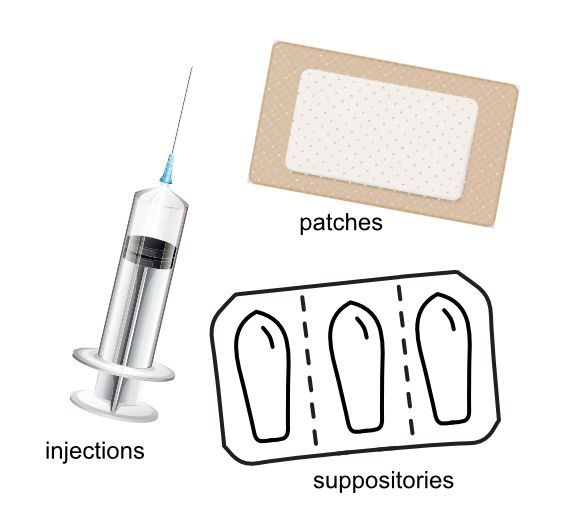Different ways of taking medications
When a person thinks about different ways of taking medications, what comes to mind would include: by mouth (orally), maybe by the skin (cream or a patch), or maybe solid vs liquid. When a pharmacist thinks of the options for medication administration, s/he thinks not only of what would work best for the medication's absorption, effectiveness, and availability, but also what would work best for the patient's age, lifestyle, and limitations.
This blog will cover some generic information, and if you have any questions about your or a loved one's medications, please don't hesitate to talk with one of our pharmacists, since each situation is unique.
Below are the main ways of taking medications and some thoughts about each.
Oral
One of the most common methods is to take a pill by mouth. Convenient, more or less easy or agreeable, it works well for people who have no issues with swallowing. Sometimes if a person (often a child) has trouble with a bad-tasting liquid medicine, a pharmacist can add a flavoring to mask the bad taste.
Some pills are coated with a time-release substance or have another mechanism so that the active ingredient is released over time, so pills that are intended to be swallowed whole should not be crushed.
Sometimes tablets or liquid medications are placed under the tongue rather than swallowed. There is an abundant network of capillaries and lymphatics* under our tongue, which results in faster medication action.
Taking medications under the tongue also avoids the stomach and liver, a path which diminishes drug concentrations. Concentration levels of pills made to be swallowed take this into account, so we should always follow instructions for how to take a medication.
Besides the speed of medication delivery under the tongue, another consideration is if a person might have excessive saliva, which could cause the medication to dissolve too quickly. Or if a person finds it hard to keep something under their tongue for a period of time without swallowing it, the sublingual method might not be best for them.
Some medications are administered in the mouth next to the cheek. This method results in slower absorption than under the tongue because buccal tissue is less permeable than sublingual tissue, but it still does avoid the stomach and liver path.
Inhalation and intranasal
Another area of the body that allows medications to enter the bloodstream quickly is in the respiratory tract. This method also bypasses the stomach and liver path.
Some medications are administered using a nebulizer, a machine that changes medication from a liquid to a mist so one can inhale it into the lungs. While there is a large surface area in the lungs and they are close to rich blood flow, medications administered using this path might not reach their destination because of obstacles along the way such as the aerodynamic filter of the lungs and the mucus lining the airways.
Other drugs are sprayed into the nose and get absorbed through the thin membrane that lines the nasal passage. To note, we administer FluMist, a nasal spray flu vaccine, and appointments can be made via the Vaccines page of our website.
This blog doesn't cover all the variables that can go into determining the best administration method, which can sometimes be very specific to individuals. For example, someone suffering from the common cold, or allergies, or a sinus infection, might not want to take their flu vaccine via a nose spray.
Rectal
This method is apparently more common in Europe than in North America, but it is useful especially for infants and the elderly, or in emergency situations where a person cannot swallow.
While not all drugs can be administered via the rectum, suppositories may prevent having some side effects caused by some swallowed drugs (ie gastric irritation, nausea, vomiting).

Intramuscular and subcutaneous
Vaccines are commonly administered via intramuscular injection, meaning vaccines are injected into a muscle. To note, this is not the same as a subcutaneous injection, which involves injecting into a layer of fat between the skin and the muscle. Insulin is a medication that needs to be injected subcutaneously.
A notable disadvantage of the intramuscular and subcutaneous methods is possible pain or discomfort at the injection site.
Transdermal
Drug delivery can also take place via patches on the skin. For example, some motion sickness medications are administered this way. Transdermal creams and gels are also made to penetrate the skin, resulting in active ingredients crossing the skin barrier and often having an effect on other areas of the body, not just on the part of the skin where the ingredients are applied.
Advantages of this method include that it is not invasive and that it by-passes the stomach and liver path. However, for reasons such as molecular size and structure, not many medications have been approved for transdermal administration.
To note, transdermal is not the same as topical. Topical applications rely instead on passive diffusion into the skin itself, creating just a local effect.
Conclusion
It can be understood from this cursory overview that many factors go into deciding the best way to administer a medication. Drug manufacturers' research and development programs and the FDA's approval process aim to ensure both drug safety and efficacy, so it is best to closely follow the instructions for each medication.
Finally, a research study published in 2022 found that when taking pills orally, our body position can make a difference! Essentially, because most pills start to work after they are ejected by the stomach into the intestine, the closer a pill lands to the lower part of the stomach, the faster it dissolves and gets absorbed by the intestine.
Due to the natural asymmetry of the stomach and to gravity, the best body position for this to happen is ... lying on our right side!
Have medication-related questions?
Please know that our pharmacists are available 7 days a week and will work with you and let you know the options for your situation -- just ask:
- if you have difficulties with side effects
- if you need a refresher on how to use a medication device or how best to take medications
- if your medication doesn't seem to be working after a reasonable amount of time
References and resources
*Lymphatics are tissues related to the lymph system, which is part of the immune system and which transport fluids in the body.
- National Library of Medicine on medication routes of administration - https://www.ncbi.nlm.nih.gov/books/NBK568677/
- National Library of Medicine on transdermal medications - https://www.ncbi.nlm.nih.gov/pmc/articles/PMC2700785/
- Gensco Pharma on the difference between topical and transdermal medications - https://genscopharma.com/difference-topical-transdermal-medications/
- Johns Hopkins Medicine on medication management and safety tips - https://www.hopkinsmedicine.org/health/wellness-and-prevention/help-for-managing-multiple-medications
- American Academy of Pediatrics on how to use liquid medicines for children - https://www.healthychildren.org/English/safety-prevention/at-home/medication-safety/Pages/Using-Liquid-Medicines.aspx
- Johns Hopkins University Magazine on how posture affects taking pills - https://hub.jhu.edu/2022/08/16/the-best-posture-to-take-a-pill/





